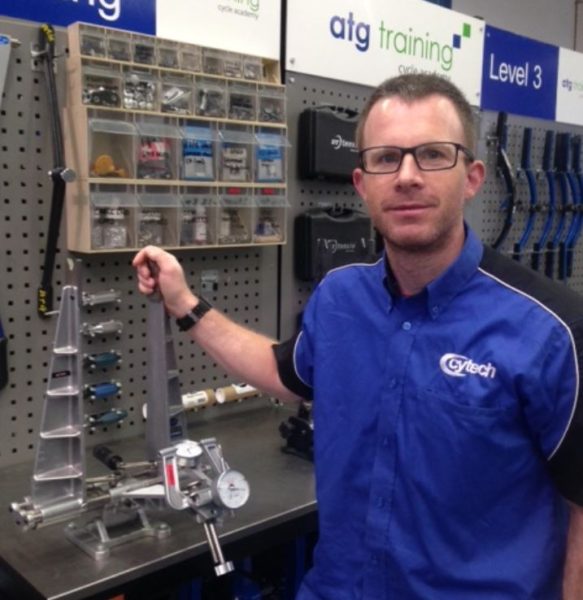Training: The importance of di2 updates and customisation
By Julian Thrasher, ATG Training 
Applying Di2 updates is an effective way of getting your customers back into the shop where they will hopefully make additional purchases whilst the update is being applied – a gel and a C02 cartridge or (depending on the salesperson) a brand new bike… all money in the till that wouldn’t have happened had the customer been on the premises. Keep an eye on Shimano’s e-tube project webpage (e-tubeproject.shimano.com/firmware) for the latest update patches. If you keep a record of your customers’ bikes and the Di2 groupset and check the site to see when a new update becomes available, you can contact the customer and arrange for them to book the bike in for the update to be completed. Pricing for updates varies widely and it’s not for me to tell you how much you should (or shouldn’t) charge – but we’ve had mechanics through on the Cytech Technical courses who have charged from nothing all the way up to £35. I guess knowing your customer will help a lot in knowing how to price this work.
Di2 needs the latest firmware installed in each of the components to effectively ‘talk’ to each other. It’s possible that if the Di2 groupset has been purchased sporadically in drips and drabs then the firmware in each of the components will be a different version. A quick plug in via SMPCE1 (or a check wirelessly with the e-tube project App) will flash up any components not installed with the latest firmware – of course (providing you keep e-tube project itself up to date) simply installing the components to the bike in the hope that the firmware versions are the same can be a bit of a lottery in this instance. This could manifest itself as a Di2 groupset that fails to respond even though the battery has a full charge.

The App based version of e-tube project really comes into its own when in the field (almost literally when it comes to ‘cross and mountain bikes!) allowing quick adjustments when it would be impractical to have a laptop or PC connected to the bike. It’s great to now have it available on Android as well as iOS, but be aware that the version of Bluetooth Shimano have used to communicate is the ‘LE’ type which not all types of tablets or phones have. If you are not sure if the device you have will work or not, check the e-tubeproject.shimano.com/application tab for a list of currently supported devices.
We’ve had issues where more than one mechanic tries to pair (wirelessly) with the bike, in this case of course only one will be successful. The App allows you to password protect the Di2 groupset, but the problem with this is that you have to document the password somewhere to enter it later (customers details would be a good place to do this) and the device can sometimes hold old passwords in its memory which will flag up that the passkey you enter is incorrect. If this happens then go into your Bluetooth settings on your device, tap the ‘I’ symbol next to the device and then tap ‘forget this device’ you will need to complete the pairing process again to re-pair the device to the Di2.
For customers with the older 9070 or 6870 Di2 groupsets a good upgrade (and potential sales opportunity) is the battery (either to a BT-DN110 internal or BM-DN100 external cradle) and install a D-fly wireless communicator to allow the use of the Bluetooth wireless feature, but also to allow the groupset to communicate wirelessly via the Ant+ protocol with a Garmin or the increasingly popular Wahoo head units. This is a cool feature that gains a whole load of features including battery percentage remaining, which gear you are in and (leading us neatly into the next piece) you can configure the shifter buttons of the Di2 (on the Garmin Edge units at least) to the customers’ individual requirements.
Customising Di2 for the customer is a great way to offer your advice and expertise to effectively ‘tailor fit’ the bike to the customer, much like you would with brake lever set up (lever reach) and we can use e-tube project to create personalized customer presets based around the way that the customer rides. These presets can be saved to either your desktop or mobile device and then used in the future. So in the case of a ‘cross bike where the rider may be lucky enough to have two (or more) spare bikes, we can use these preset files to ensure that each bike shifts exactly the same, or we could look at the conditions and have a set up that would be used later in the race. If the course dried or got muddier, we could have an individualised set up that reflected what the rider wanted from the shifting. Note that if you get carried away and cannot remember how the Di2 was configured to begin with and you have not saved a preset file, then clicking the ‘restore default values’ button will not be of much help as this will restore it to Shimano’s default settings, not the customer’s.
Bear in mind that this is open source material (meaning that you don’t have to be a dealer equipped with a password to access the e-tube project site) so it’s feasible – especially so with the App based e-tube project – that the customer can download the updates and customise the Di2 themselves, but we usually know how this ends up…



